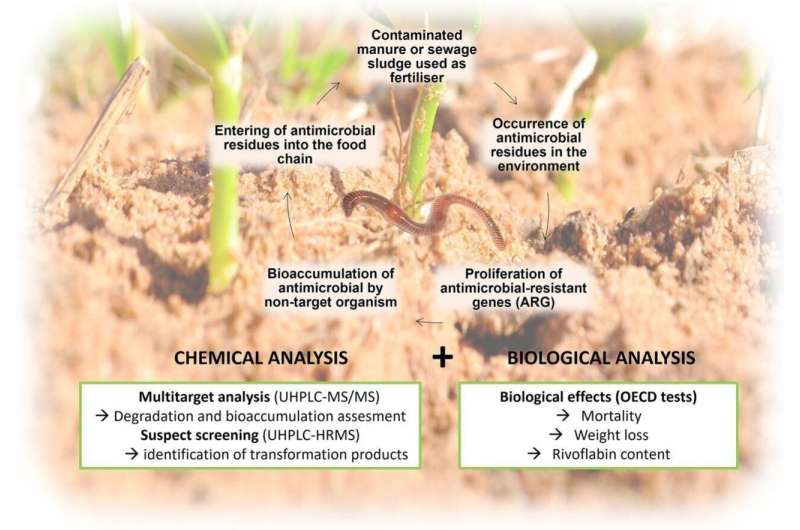This article has been reviewed according to Science X's editorial process and policies. Editors have highlighted the following attributes while ensuring the content's credibility:
fact-checked
peer-reviewed publication
trusted source
proofread
Developing novel methods to detect antibiotics in vegetables and earthworms

UPV/EHU researcher Irantzu Vergara has managed to simultaneously analyze several families of antibiotics in vegetables and earthworms. Sampling carried out in various locations of the Basque Autonomous Community has yielded data on the existence of antimicrobial agents and their derivatives in vegetables. Vergara stresses the need for further research to address the problem of contamination by this type of medication in the environment.
"The massive use of antibiotics and antimicrobials in people and animals has led to these substances appearing in unexpected environmental samples," said Irantzu Vergara, researcher in the UPV/EHU's IBeA group.
Drugs that do not end up fully metabolized in the body reach the environment through various routes (such as manure, sewage sludge used as fertilizers, etc.), are leached into the soil and may end up transferring to crops or earthworms, which are at the base of the food chain.
"Although no short-term toxicity has been demonstrated in humans, the unintended consumption of antibiotics in the diet can cause problems for allergic individuals; and the effects of long-term exposure remain unknown.
"However, the biggest problem associated with this contamination is the spread of multi-resistant bacteria; it is difficult to find an effective treatment in the event of infection, which is responsible for 33,000 deaths per year across Europe," explained Vergara.
To address this problem, the IBeA research group has developed two analytical methods enabling very low concentrations of antimicrobials in vegetables and earthworms to be detected. "Although high drug concentrations can be expected in manure, much lower concentrations are expected after these substances have transferred to plants or earthworms, so sensitive methods are needed to detect them," said Vergara.
The methods developed by Vergara in the UPV/EHU labs enable a wide range of antimicrobial drugs to be simultaneously determined, as well as various products deriving from their transformation. The findings are published in the journal Science of The Total Environment.
As the researcher explained, "The drugs can be excreted in their original form or transformed after being metabolized (after undergoing certain changes in the body). What is more, these are very sensitive compounds which, under conditions of temperature, humidity, light, etc., can be very easily degraded and transformed in the environment."
The methods constitute a significant breakthrough, as "until now there have been no analytical methods to simultaneously study a wide range of antimicrobials in plants and earthworms, and they did not focus on the analysis of transformation products, either.
"Each family of antibiotics has different physicochemical properties, and it is very important that the same analytical method can be used to analyze all of them. We have also achieved pretty low detection limits, which allow us to detect very low concentrations of these substances in the environment."
Samples of vegetables taken in different locations across the Basque Autonomous Community
In the case of vegetables, the research group took samples from different locations of the Basque Country, from both organic and non-organic agriculture. "We set out to measure the scale of the antibiotics problem in the Basque Autonomous Community.
"The analytical studies conducted revealed data on the existence of antimicrobial drugs and their derivatives in vegetables: we found that there is a transfer of both antimicrobials and degradation products between soil and vegetables. In other words, there is a problem of antimicrobial contamination in the Basque Country," Vergara added.
In the case of earthworms, however, they conducted an experiment under controlled conditions of exposure. "We wanted to check whether, in the case of contaminated soil, the earthworms that feed on this soil are able to accumulate antimicrobials in their bodies. The study did in fact reveal an accumulation of these antimicrobials in the body, which generate a large variety of previously unreported transformation products."
Vergara stressed the need to "continue multidisciplinary research along these lines, as this is a problem that is going to affect everyone over the coming decades." Water treatment plants currently do not have fully effective treatments to remove residual drugs, and this water is often used for irrigation.
"As there is such a large, constant input of antimicrobials into the environment, the bacteria are getting used to coexisting with them and generating resistance," she explained. "In fact, there are already cases in which there are no effective treatments for people who become infected with multi-resistant bacteria. It is important to drive forward research in order to minimize the problem or to start to look for solutions in the short to medium term."
More information: I. Vergara-Luis et al, Antimicrobials in Eisenia fetida earthworms: A comprehensive study from method development to the assessment of uptake and degradation, Science of The Total Environment (2024). DOI: 10.1016/j.scitotenv.2024.171214
Journal information: Science of the Total Environment
Provided by University of the Basque Country




















